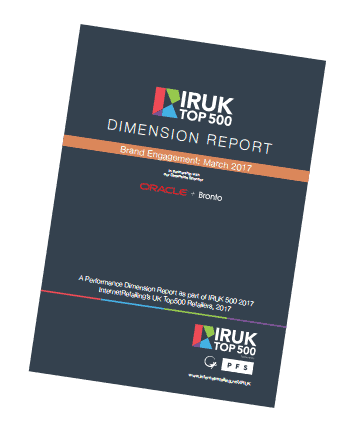The latest IRUK Top500 Performance Dimension Report looks at brand engagement. Emma Herrod shares some of the findings.
AT a time when customers are taking the lead in the way they communicate and interact with retail brands, it makes sense that the way retailers respond is changing. Indeed, it’s important that they do so in order to ensure they stay relevant to the shoppers they serve.
The latest IRUK Top500 Brand Engagement Performance Dimension Report, as sponsored by Oracle-acquired Bronto , is the first based on IRUK Top500 2017 data, and looks in-depth at where brand engagement is now. The InternetRetailing research team start with the hard data and, working with InternetRetailing Knowledge Partners, who have analysed how retailers set about communicating with customers, have gone on to measure how responsive they are when those customers get in touch
From that, the team draws real insights into what makes for successful brand engagement, looking at how leading IRUK Top500 retailers develop strategies that enable them to be both engaging and responsive as they open and develop two-day conversations. By being present where customers expect them to be they encourage shopper loyalty among that group of customers that is most likely to spread the word across social channels. That in turn raises brand awareness.
But the focus in the Brand Engagement Performance Dimension Report is primarily on painting a picture of what is happening, rather than exploring theoretical possibilities. That’s why InternetRetailing takes a highly practical approach to measuring brand engagement and customer service across channels, illustrated by interviews and real-life case study examples of what works for the retailers that stand out in this dimension, and across the Top500.
The case study on House of Fraser , for example, looks at how the department store retailer is reminding customers “we love them”. As the company’s Chief Customer Office David Walmsley says, “The focus is always on how loyal the customer is to us, rather than how loyal we can be to them.”
GETTING SOCIAL
In recent years, there’s been much discussion among analysts not just about the effectiveness of social media in a retail context, but even in some cases whether retailers should use social media as a selling tool at all. That debate is surely over. Broadly, InternetRetailing’s research shows that British retailers have embraced social media as ardently as their customers.
It’s easy to see why. A Facebook presence is now the minimum shoppers expect of their favourite retailers. Increasingly, shoppers also expect to see retailers active on such channels as Twitter, YouTube and Instagram, especially when it comes to brands catering to digital natives. Accordingly, it’s not surprising that amongst the best-performing retailers in this Dimension, Topshop, Victoria’s Secret and Forever 21 all out-performed competitors in key social media metrics.
However, that’s by no means the whole picture. The electrical retailer Currys performed strongly for offering social validation, the facility to Like items and share them with friends.
Even more revealing in showing what can be achieved is Myprotein. The sports nutrition specialist ranked a truly impressive 397 places above the place its Top500 Footprint would suggest. That’s in great part because it enables its visitors to Like products and to validate them on social media, while also offering product star ratings via its mobile app. The wider lesson of Myprotein’s approach may be that the retailer has successfully scaled up a traditional strength of specialists: sharing expertise with customers about products that, to the uninitiated, can seem arcane and overly complex.
The research team also looked at email communication. While the channel-hopping behaviour of millennials can make it seem as if email use is declining, it remains the most preferred channel across all demographics. When a 2016 study by Bluecore and NAPCO Research asked consumers how they would prefer to receive brand communications, 68% chose email. Even allowing for this figure being skewed by the attitudes of older consumers, it’s a stark reminder that email remains a great way to start conversations.
NOT FORGETTING EMAIL
In this context, it’s fascinating to see so many trusted, mid-market retailers performing strongly when it comes to email. Debenhams, for example, performs strongly in terms of not only sending out emails that aren’t treated as spam by recipients, but their emails have a high read rate. Mothercare too sends out emails that its customers are more likely to read than those of competitors, as do Argos and John Lewis. M&S outperforms competitors in terms of sending emails that its customers don’t treat as spam.
The five retailers mentioned above are also interesting in that none of them rely wholly on email to achieve their high rating in the Brand Engagement Performance Dimension. Rather, each excels in a variety of metrics that we measured. Debenhams enables consumers to Like products. Mothercare makes it easy for customers to share product reviews and ratings, especially useful for new parents buying a buggy or cot for the first time, you’d imagine.
Looking outside these five retailers, House of Fraser performs strongly for a combination of offering product reviews and ratings, and sending out emails that have a high read rate. It communicates effectively via email and it’s also good at the softer art of getting customers to talk about products. Amazon’s emails are more often forwarded than those of competitors. It’s rightly noted for its user-generated product reviews and product ratings.
“The focus is always on how loyal the customer is to us, rather than how loyal we can be to them.”
Leave aside for a moment the individual factors – company culture, customer demographics, etc – that may shape where these retailers choose to focus their resources in the disciplines we measure for the Brand Engagement Performance Dimension, one thing united these retailers: they work at scale. In a sense, it would be surprising if they didn’t perform strongly.
However, the research team is keen to point out that it’s not just larger retailers that perform well in this Dimension. Already noted is Myprotein, which drives a strong performance through social media. Other companies also sit more than 200 places above their overall ranking in this Dimension. Why is this? In the case of lingerie retailer Victoria’s Secret, it’s down to a combination of making products easy to Like, social validation and the way it offers product ratings, not so far removed from the mid-market retailers we’ve already analysed.
In contrast, fast-fashion retailer Forever 21 has far more in common with Myprotein. It performs strongly for offering shoppers the ability to share items on social media, and for not just letting customers Like products, but persuading its shoppers to Like pages. Here, perhaps, lie the bare bones of a customer engagement strategy for any company aiming at millennials and digital natives.
Looking beyond segments, the fact that different retailers excel at different metrics measured for the Brand Engagement Performance Dimension shouldn’t be taken as evidence that the findings don’t potentially reveal anything about best practice.
While this goes a little beyond the research remit, one way to explain the nuances in the findings is to observe that we’re entering an era when customers will retailers to initiate and continue conversations across a whole range of channels. As the research is refined, InternetRetailing fully expects examples of practice that are currently at the cutting edge to become mainstream. There will be a levelling up.
However, that doesn’t mean the research will cease to be relevant. Rather, the researchers intend to refine their techniques so that they are looking at new methods. As it becomes easier to link store and digital, for example, will retailers be nimble and technologically savvy enough to help store assistants continue conversations started online? Today, this is difficult. In the months and years ahead, it will become increasingly commonplace.
The researchers welcome your thoughts via research@internetretailing.net.






